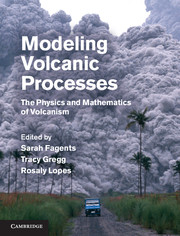Book contents
- Frontmatter
- Contents
- Contributors
- Chapter 1 Introduction
- Chapter 2 Magma chamber dynamics and thermodynamics
- Chapter 3 The dynamics of dike propagation
- Chapter 4 Dynamics of magma ascent in the volcanic conduit
- Chapter 5 Lava flows
- Chapter 6 Unsteady explosive activity
- Chapter 7 Unsteady explosive activity
- Chapter 8 Sustained explosive activity
- Chapter 9 Modeling tephra sedimentation from volcanic plumes
- Chapter 10 Pyroclastic density currents
- Chapter 11 Magma–water interactions
- Chapter 12 Deep-sea eruptions
- Chapter 13 Volcano–ice interactions
- Chapter 14 Modeling lahar behavior and hazards
- Chapter 15 Introduction to quantitative volcano seismology
- Chapter 16 Volcano acoustics
- Chapter 17 Planetary volcanism
- Index
- Plate section
- References
Chapter 3 - The dynamics of dike propagation
Published online by Cambridge University Press: 05 March 2013
- Frontmatter
- Contents
- Contributors
- Chapter 1 Introduction
- Chapter 2 Magma chamber dynamics and thermodynamics
- Chapter 3 The dynamics of dike propagation
- Chapter 4 Dynamics of magma ascent in the volcanic conduit
- Chapter 5 Lava flows
- Chapter 6 Unsteady explosive activity
- Chapter 7 Unsteady explosive activity
- Chapter 8 Sustained explosive activity
- Chapter 9 Modeling tephra sedimentation from volcanic plumes
- Chapter 10 Pyroclastic density currents
- Chapter 11 Magma–water interactions
- Chapter 12 Deep-sea eruptions
- Chapter 13 Volcano–ice interactions
- Chapter 14 Modeling lahar behavior and hazards
- Chapter 15 Introduction to quantitative volcano seismology
- Chapter 16 Volcano acoustics
- Chapter 17 Planetary volcanism
- Index
- Plate section
- References
Summary
Overview
The aim of this chapter is to provide an overview of physical models of the dynamics of propagation of magmatic dikes. Experimental studies of fissure propagation provide an important way of validating hypotheses made in theoretical models, and hence provide a vital link between theory and field observations. Geological field observations of dikes can provide detailed information about rock and magma properties and post-emplacement dike geometry, but do not permit assessment of propagation rates. Conversely, geophysical studies can record dike emplacement as it takes place, allowing estimates of speed or demonstrating intermittency of propagation, but giving little information about dike geometry. We highlight some examples of field observations of dike dynamics that provide useful constraints for models. We discuss the main assumptions and key results of theoretical models that treat dike emplacement into both homogeneous and heterogeneous media. These models predict both the geometry of a propagating dike and the emplacement dynamics (e.g., speed), although they require assumptions about the source conditions, such as magma supply rates. There are open questions arising from shortcomings of current theory, which can be addressed using laboratory experiments that permit detailed investigation of real-time geometric and dynamic information. Notable among recent studies are attempts to quantify factors that may lead to arrest of a dike before it reaches the surface, the potential for solidification to influence the dynamic regime of propagation, and the influence of three-dimensional fracturing effects on propagation.
- Type
- Chapter
- Information
- Modeling Volcanic ProcessesThe Physics and Mathematics of Volcanism, pp. 32 - 54Publisher: Cambridge University PressPrint publication year: 2013
References
- 4
- Cited by



